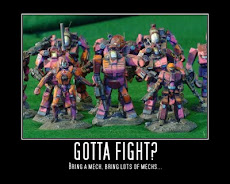After the paint peeled off these models, stripping them back to bare metal effectively meant I'd taken a one step back towards completing this project. Its not as if I don't want to finish them unless they're perfect, though there's some truth in my wanting to make them look as good as possible.
Instead, it's more like I think it would be a shame to waste an opportunity to try and make the most of a bad outcome, as I didn't want to let all the work I had lost bring me down.
So I chose to see it as a second chance to do the best job I can with these classic RAFM miniatures.
 |
Green stuff is
easier to sculpt when you want organic shapes, but Milliput is better
for filing into shape when you want flat surfaces, and parts to be
square. But on more than one occasion I mixed them both together, because green stuff can be annoyingly sticky to work with.
The work I carried out included re-sculpting the arm joints on the model on the left, and then rotating the left hand so it sits better with the main gun.
I also reposed the legs of the other two models. In addition, I rebuilt the torso of the model on the right. I might, if I can figure a way of doing so, make a flexible ammo chute feed for it too.
Doing so would give me more flexibility when pose it for pictures, as now all the arms and the torsos on the models can be moved.
But, I'm pleased at how their stances turned out. I think they look more dynamic now, and it has motivated to get on with painting them – again!
Unfortunately, these shots don't show the work I've done texturing the bases sculpting in foot prints and track marks. The feedback from the first two models I finished pointed out that the bases were a bit bare.
I thought the critique was fair. The bases were a bit plain.
I'm not big on fancy bases, but given the amount of work I've put into these I thought I'd give it a go, and see what I could do to raise my game. After all, it can't hurt.
And finally, given this project turned into a labour of love, here's a reminder of what they looked like the first time round. I think I can safely say I've definitely taken them to another level.











.png)





